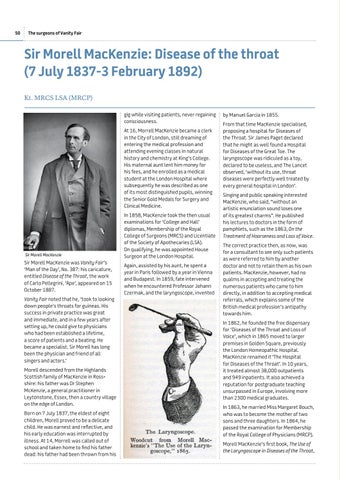50
The surgeons of Vanity Fair
Sir Morell MacKenzie: Disease of the throat (7 July 1837-3 February 1892) Kt. MRCS LSA (MRCP) gig while visiting patients, never regaining consciousness. At 16, Morrell MacKenzie became a clerk in the City of London, still dreaming of entering the medical profession and attending evening classes in natural history and chemistry at King’s College. His maternal aunt lent him money for his fees, and he enrolled as a medical student at the London Hospital where subsequently he was described as one of its most distinguished pupils, winning the Senior Gold Medals for Surgery and Clinical Medicine.
Sir Morell MacKenzie
Sir Morell MacKenzie was Vanity Fair’s ‘Man of the Day’, No. 387: his caricature, entitled Disease of the Throat, the work of Carlo Pellegrini, ‘Ape’, appeared on 15 October 1887. Vanity Fair noted that he, ‘took to looking down people’s throats for guineas. His success in private practice was great and immediate, and in a few years after setting up, he could give to physicians who had been established a lifetime, a score of patients and a beating. He became a specialist. Sir Morell has long been the physician and friend of all singers and actors.’ Morell descended from the Highlands Scottish family of MacKenzie in Rossshire: his father was Dr Stephen McKenzie, a general practitioner in Leytonstone, Essex, then a country village on the edge of London. Born on 7 July 1837, the eldest of eight children, Morell proved to be a delicate child. He was earnest and reflective, and his early education was interrupted by illness. At 14, Morrell was called out of school and taken home to find his father dead: his father had been thrown from his
In 1858, MacKenzie took the then usual examinations for ‘College and Hall’ diplomas, Membership of the Royal College of Surgeons (MRCS) and Licentiate of the Society of Apothecaries (LSA). On qualifying, he was appointed House Surgeon at the London Hospital. Again, assisted by his aunt, he spent a year in Paris followed by a year in Vienna and Budapest. In 1859, fate intervened when he encountered Professor Johann Czermak, and the laryngoscope, invented
by Manuel Garcia in 1855. From that time MacKenzie specialised, proposing a hospital for Diseases of the Throat. Sir James Paget declared that he might as well found a Hospital for Diseases of the Great Toe. The laryngoscope was ridiculed as a toy, declared to be useless, and The Lancet observed, ‘without its use, throat diseases were perfectly well treated by every general hospital in London’. Singing and public speaking interested MacKenzie, who said, “without an artistic enunciation sound loses one of its greatest charms”. He published his lectures to doctors in the form of pamphlets, such as the 1863, On the Treatment of Hoarseness and Loss of Voice. The correct practice then, as now, was for a consultant to see only such patients as were referred to him by another doctor and not to retain them as his own patients. MacKenzie, however, had no qualms in accepting and treating the numerous patients who came to him directly, in addition to accepting medical referrals, which explains some of the British medical profession’s antipathy towards him. In 1862, he founded the free dispensary for ‘Diseases of the Throat and Loss of Voice’, which in 1865 moved to larger premises in Golden Square, previously the London Homeopathic Hospital. MacKenzie renamed it ‘The Hospital for Diseases of the Throat’. In 10 years, it treated almost 38,000 outpatients and 949 inpatients. It also achieved a reputation for postgraduate teaching unsurpassed in Europe, involving more than 2300 medical graduates. In 1863, he married Miss Margaret Bouch, who was to become the mother of two sons and three daughters. In 1864, he passed the examination for Membership of the Royal College of Physicians (MRCP). Morell MacKenzie’s first book, The Use of the Laryngoscope in Diseases of the Throat,





























